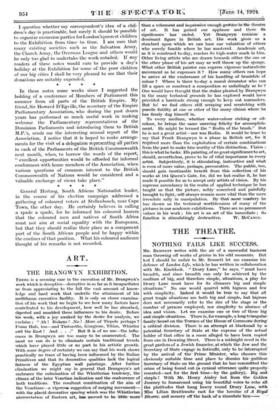ART.
THE BRANGW YN EXHIBITION.
TtzknE is a seeming ease- in the execution of Mr. Brangwyn's work which is deceptive—deceptive in so far as it incapacitates us from appreciating to the full the vast amount of know- ledge and hard work that underlie the attainment of his mellifluous executive facility. It is only on closer examina- tion of his work that we begin to see how many factors have contributed to his development, how well he has absorbed, digested and moulded these influences to his desire. Before his work, wtth- a joy awaked by the desire for analysis, we exclaim : "Alt I Ruhens ! ! -More -of Tiepolo perhaps-7. Franz Hals, too—and Tintoretto, Giorgione, Titian, Whistler and the -FAA ! And . . ." But it is of no use—the influ- ences in Brangwyn are too many :to be enumerated. The most we can do is to eliminate certain traditional trends which have played little or no part in his artistic growth. With some degree of certainty we can say that his work shows practically no trace of having been influenced by the Italian Primitives and that its decorative qualities lack the logical flatness of the Egyptian wall paintings. After further elimination we might say in general that Brangwyn's art embraces the culmination of the Whistlerian tendency, the climax of the later Venetian indication and the coalescence of both traditions. The resultant -combination of the aim of the Venetians—a vigorous suggestion of surging movement— with the placid decorative spacing which was the Whistlerian nternretation of Eastern art, -has 'Droved to be little more
•
`than a vehement and impressive enough gest:It:eh-A.4e theatre
of art. It has gained our applause and theie its
'significance has " elided. Yet :Brangwyn iertiairis' a dominant figure 'in British art. " His • 'Work gives us- a standard upon-Which we can base our • valuationr of 7others who merely nimble where he has -mastered.- art, as it iS construed to-day, reaches its high-Water mark in him. Other 'living attiSts-whO are draWn-ttivrardS either the One or the other phase Of his -art may as-well throw up the sponge What other British painter can" eXpre■Ss 'vigorous 'nattiralistie movement as he expresses it ? HOW aittoy °thee; - can hope to arrive at the exuberance of -his :handling of brushfuLs of colour ? Where is -there to-day a mural-decorator-who can fill a space or construct a composition so unfailingly as he ? One would-have thought that the stakes planted by Brangwyn in the many technical gibunds he has explored would have prOvided a 'barricade strong, -enough 'to 'keep Out marauders. But lo! we find others still scraping and scratching with puerile futility at one or other of the many -claims where ' he has firmly dug himself in.
To every medium, whether water-colour etching', or oil.; colour, he brings the • same unerring -felicity "for accomplish- ment. He :might be termed the "Rodin of the brush." But he is-not-a great artist—nor was Rodin. It would be truer to say that Frank Brangwyn is a phase in British art, for it required more than the exploitation of certain combinations from the past to-make-him-worthy-of this distinction. Melon : this is *hathe lacks: His painting, of no great significance to art; should, nevertheless; provelnbe Of vital importance to every artist. Subjectively, it is stimulating, instructive and What is even of more value, -perhaps,•provocative. The public, too, should gain :inestimable benefit from this colle•ction - of his works at 184 'Queen's Gate, for, did we but, realize it, he has made it possible for us to accept only artists of Vision. By his supreme aseendaney in the realm of applied technique Ile has taught us 'that the picture, nobly' conceived afid painfully brought to- light,..wffi-alwaysTemain more-vital than the mere irresolute sally in manipulation. By -that 'same --mastery he has shown us the technical --worthlessness of many of the pictures in our academic exhibitions. There are no permanent values in his work ; his art is an art of the immediate ; its
function is stimulatingly destructive. W. McCANcE.










































 Previous page
Previous page